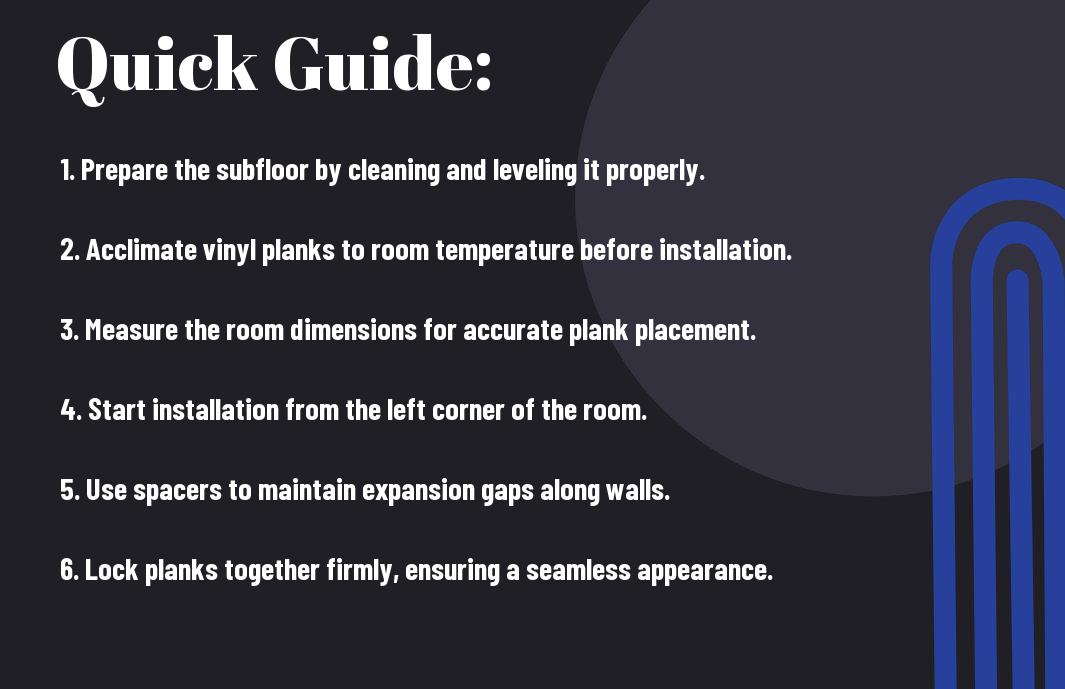Installation of SPC vinyl flooring can transform your space while providing a durable and elegant finish. This guide is designed to help you through each step of the process, ensuring that you achieve a professional-looking result with confidence. From preparation to the final touches, you will find valuable tips and insights that will simplify your installation experience, enabling you to enjoy your beautiful new floor for years to come.

Understanding SPC Vinyl Flooring
A stylish and durable flooring option, SPC (Stone Plastic Composite) vinyl flooring combines an impressive design aesthetic with practical functionality. Designed to mimic the look of natural wood or stone, SPC flooring is renowned for its resilience against moisture, scratches, and high foot traffic, making it an ideal choice for various indoor settings.
Types of SPC Vinyl Flooring
There are several types of SPC vinyl flooring available to cater to different preferences and flooring needs. Options typically include:
- Rigid Core SPC
- Luxury SPC Planks
- SPC Tiles
- Heterogeneous SPC
- Printed and Embossed SPC
This variety allows you to find the perfect style that complements your home’s decor.
| Type | Description |
|---|---|
| Rigid Core SPC | Sturdy core designed for stability. |
| Luxury SPC Planks | High-end design with rich finishes. |
| SPC Tiles | Square design, ideal for modern spaces. |
| Heterogeneous SPC | Multi-layer construction for durability. |
| Printed and Embossed SPC | Textured finishes for enhanced realism. |
Pros and Cons of SPC Vinyl Flooring
Now, let’s explore the advantages and disadvantages of SPC vinyl flooring to help you make an informed decision:
| Pros | Cons |
|---|---|
| Water-resistant | May feel cold underfoot |
| Durable and scratch-resistant | Limited design options compared to wood |
| Easy to clean and maintain | Can be noisy without underlayment |
| Simple installation | Surface can be damaged by heavy impacts |
| Comfortable underfoot compared to traditional vinyl | Higher initial cost than laminate |
Understanding the pros and cons of SPC vinyl flooring helps you evaluate whether it aligns with your specific lifestyle and environment. The water-resistant nature and durability of SPC flooring make it a popular choice, while drawbacks like limited design options and potential coldness underfoot might be a concern. Balancing these aspects will enable you to make the best choice for your space.
Key Factors to Consider Before Installation
The success of your SPC vinyl flooring installation hinges on several key factors. Take the time to assess these elements before you begin:
- Subfloor condition
- Moisture levels
- Material compatibility
- Room acclimation
- Installation method
Any oversight here can lead to complications later on.
Subfloor Preparation
Before you proceed with installation, it is vital to ensure your subfloor is clean, dry, and level. Any debris or moisture can compromise the adhesion of your SPC vinyl flooring. You may need to patch cracks or fill in low spots to create a solid and smooth surface. This step lays the foundation for a long-lasting and visually appealing flooring finish.
Environmental Conditions
Installation requires consideration of your home’s environmental conditions. Ensure that the temperature is consistent between 65°F and 85°F, and maintain humidity levels between 30% and 50%. This creates an ideal atmosphere for your vinyl flooring to expand and contract as needed, minimizing the chance of warping or buckling.
With the right environmental conditions, you can ensure a successful installation. Fluctuations in temperature and humidity can lead to issues over time, affecting both the aesthetic and structural integrity of your flooring. Plan your installation when the conditions are stable and avoid extreme weather changes to get the best results.
Step-by-Step Guide to Installation
Assuming you have the right tools and materials at hand, this step-by-step guide will simplify your SPC vinyl flooring installation. Following a structured approach not only enhances the efficiency of your project but also ensures a polished finish. Below is a comprehensive breakdown of the installation process:
| Step | Task |
| 1 | Prepare the subfloor for installation. |
| 2 | Gather necessary tools and materials. |
| 3 | Acclimate the flooring to the room temperature. |
| 4 | Start installing the SPC vinyl planks. |
| 5 | Finish with trim and transition pieces. |
Tools and Materials Needed
There’s a variety of tools and materials you will need for successful SPC vinyl flooring installation. Essential items include a laminate cutter or utility knife, a tapping block, a rubber mallet, and spacers. Additionally, ensure you have an underlayment, measuring tape, and a straight edge to assist in achieving a precise fit. Having all necessary items ready will streamline your workflow and enhance the overall installation experience.
Installation Process
If you follow the outlined steps methodically, the installation of your SPC vinyl flooring can be both efficient and rewarding. First, ensure your subfloor is clean, dry, and level. Then, acclimate your flooring planks to the room’s temperature for at least 48 hours before beginning the installation. Lay the flooring according to your chosen pattern, utilizing spacers to maintain an expansion gap. Lastly, secure transition pieces for a seamless finish.
StepbyStep, once your subfloor is prepared and your planks acclimated, you can begin laying your flooring. Start by placing the first plank in the corner of the room, ensuring it’s aligned properly. Use spacers around the perimeter to account for expansion. As you lay subsequent planks, use the tapping block and mallet to lock them into place without damaging the edges. Continue this process until the entire area is covered, and finish by installing the trim and transition pieces to complete the look.
Tips for a Successful Installation
Now that you’re ready to install your SPC vinyl flooring, consider these necessary tips to ensure a seamless process:
- Always acclimate the planks to the room temperature for at least 48 hours before installation.
- Make sure your subfloor is clean, dry, and level.
- Use the right underlayment to enhance sound absorption and comfort.
- Leave a gap around the perimeter for expansion.
- Follow the manufacturer’s instructions carefully.
This will help you achieve a successful and professional-looking installation.
Common Mistakes to Avoid
Clearly, avoiding common mistakes can save you time and frustration during your installation. One frequent error is neglecting to check the subfloor for moisture or unevenness, which can lead to issues later. Additionally, failing to leave the necessary expansion gaps can result in buckling and warping. Finally, skipping acclimation can compromise the integrity of your flooring. By being aware of these pitfalls, you can set yourself up for a successful installation.
Maintenance and Care After Installation
Tips for maintaining your newly installed SPC vinyl flooring are necessary for preserving its beauty and longevity. Regular sweeping or vacuuming helps eliminate dirt and debris that can dull the surface. It’s advisable to use a damp mop with a pH-neutral cleaner for deeper cleaning, avoiding harsh chemicals or abrasive tools. Areas with heavy foot traffic may require more frequent attention, while doormats are beneficial in capturing dirt before it reaches your floors. Regularly checking for scratches or signs of wear will also aid in maintaining your flooring’s appearance for years to come.
To keep your SPC vinyl flooring looking its best, commit to a regular cleaning schedule and avoid using excessive water during mopping. It’s also wise to place felt pads under furniture legs to prevent scratches and dents. This simple maintenance routine will enhance the durability and aesthetic appeal of your flooring, ensuring it remains a beautiful addition to your space for years to come.

Final Words
So, by following these top tips for successful SPC vinyl flooring installation, you can achieve a professional-looking result in your own space. Start by thoroughly preparing your subfloor, choosing the right tools, and ensuring proper measurements. Taking your time during the installation process and paying close attention to detail will make all the difference in the longevity and appearance of your flooring. With patience and care, your new SPC vinyl flooring will not only enhance your home’s aesthetic but also stand the test of time.


